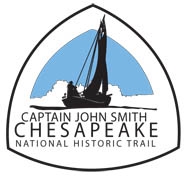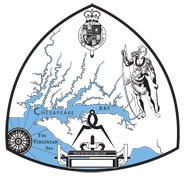

Come on a journey to remember and commemorate the history and travels of Captain John Smith!
Over four hundred years ago, Englishman John Smith and a small crew set out in an open boat to explore the Chesapeake Bay. Between 1607 and 1609 Smith mapped and documented nearly 3,000 miles of the Bay and its rivers. Along the way he visited many thriving American Indians communities and gathered information about this “fruitful and delightsome land.” In December 2006 the U.S. Congress designated the routes of Smith’s explorations of the Chesapeake as a national historic trail—the first national water trail.
Are you ready to follow in the wake of Captain John Smith? Visit sites along the National Historic Trail and learn about the native cultures and the natural environment of the 17th-century Chesapeake through the Captain John Smith Chesapeake Geotrail. The Trail provides opportunities for you to experience the Bay through the routes and places associated with Smith’s explorations. Caches will be located in museums, refuges, parks, and towns in Virginia, Maryland and Delaware along the rivers and creeks that Smith and his crew explored four centuries ago.
The Captain John Smith (CJS) Geotrail launched June 4, 2011 with over 40 caches within Maryland, Virginia and Delaware. A trackable geo coin will be awarded to the first 400 geocachers, while supplies last, for locating at least 15 CJS caches. To be eligible for the coin, geocachers must download a passport from either the CJS Geotrail or Maryland Geocaching Society website. Geocachers must find and log at least 15 finds, record the code word from each cache on their passport and post a picture of themselve at each cache location. After discovering the 15 required caches, geocachers may have thier passports validated in person or via mail at the National Park Service, Chesapeake Bay Office located at 410 Severn Ave, Suite 314, Annapolis, MD 21403. Please refer to the passport for complete validation instructions.
Participating in the CJS geotrail is fun and we hope that many people join in. However, it is not a requirement for logging your find on this cache once you find the container.
You are seeking a traditional hide. The cache is a large Lock & Lock. The hike to this cache is about 0.4 miles from parking, a total of 0.8 miles round trip. The first 0.2 miles are on trail along the bluff heading roughly north. The last 0.2 miles are bushwhacking through the pine farm and into natural forest.
Chapel Point State Park is located on the beautiful Port Tobacco River, a tributary of the Potomac River. Chapel Point is an undeveloped multi-use park that boasts a waterfront that offers excellent fishing.
Features include: Fishing - A Maryland Bay Sport Tidal License is required. Watch your tides before visiting this area. At high tide there is almost no beach. This area has a small sand launch area that is suitable for the launch of small john-boats, canoes and kayaks, and personal watercraft.
Hunting - is permitted in the 600 acre state park. The area provides suitable habitat for quail, squirrels, doves, rabbits, white-tailed deer, wild turkey and waterfowl. Game hunting is permitted during the seasons established by the Wildlife Division.
Camping - Chapel Point has a paddle-in campsite available by permit only. Call 301-743-7613 for permits. Site is available seasonally. To check tides: http://www.dnr.maryland.gov/fisheries/tides/index.asp

Chapel Point State Park is an undeveloped, 600-acre park along the Port Tobacco River, with excellent waterfront fishing, a paddle-up campsite (available by permit), and seasonal hunting. American Indians availed themselves of these same resources for generations before the arrival of English settlers, perhaps lured there by John Smith’s maps and descriptions. Smith recorded an Indian town, Potopaco, near this site, named for the people living there.
The natural resources and strategic location quickly attracted settlers, who established a town in 1634. The colonists soon displaced their Algonquin-speaking predecessors, established Port Tobacco as the seat of Charles County in 1658 and soon becoming the second-largest river port in Maryland. Like much of Maryland, the settlers were a mix of Catholics and Anglicans. Jesuits founded St. Ignatius Church in 1641, now just outside the bounds of the park, and learned the language of the Potopaco as they sought to spread the gospel and educate converts. An Anglican church was established in 1683, prior to the official establishment of Anglicanism in Maryland.
Port Tobacco flourished until the end of the nineteenth century, when the silting of the river, the increasing size of ships, and the construction of a railroad suddenly rendered the port useless. Today, a mere 15 people live in Port Tobacco Village, making it the smallest incorporated town in Maryland. The upside to this sudden decline is that numerous archaeological sites have been protected from development and disturbance. Researchers hope to learn more not only about the white planters, rich and poor, and the slaves that grew, harvested, and shipped the tobacco that gave the town its name, but also about the first people here, the Potopaco, and their interactions with the colonists who followed in John Smith’s footsteps.

Thanks to M&JThomas and Moonpie10 for helping with this hide and to the Maryland Geocaching Society for assisting with this project!